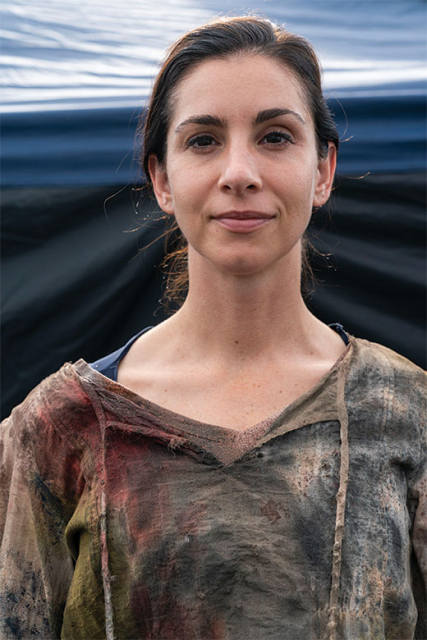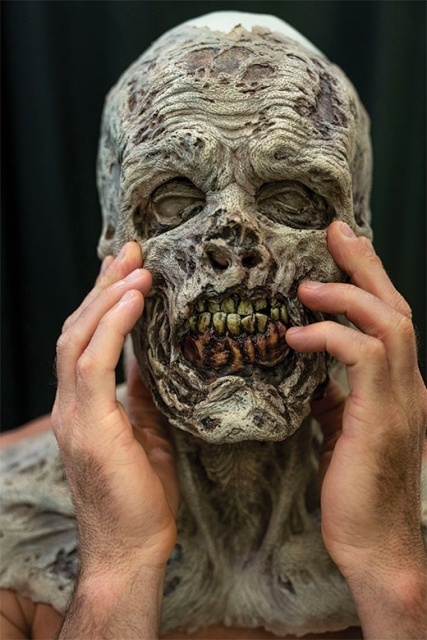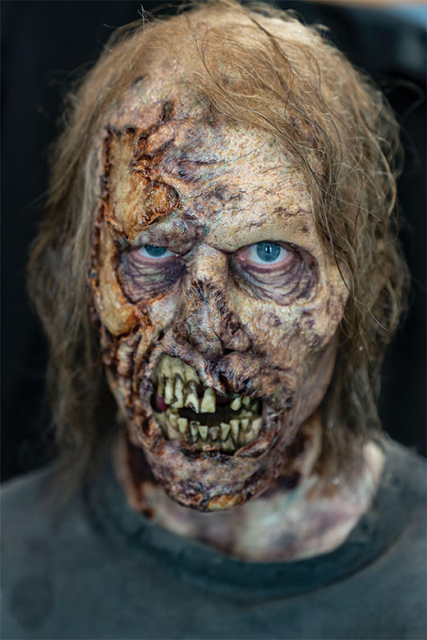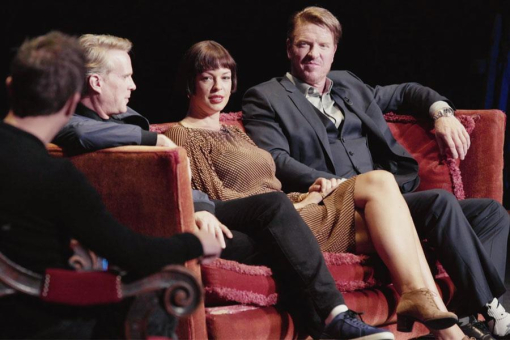I'll tell you up front: this article is not for the squeamish.
The opening photo above has already given you all the warning you need, but it's best to make that clear right away.
I'll also tell you that I'm pretty hardcore. I'm a career forensic pathologist, and I've spent more years than I'd like to say examining the bloodied and bruised bodies of people who've died violently. I've spent such a long time looking at terrible things that nothing that's been done to a human body really disturbs me.
That said, I'll confess that for the past 11 years, in every single episode of The Walking Dead there's been some moment , some horrifically over-the- top grotesque event, that has filled me with exhilarated disgust.
Of course, I've watched every episode — not just the original series, but the spinoffs Fear the Walking Dead and The Walking Dead: World Beyond, plus sundry webisodes and a decent number of behind-the-scenes clips, plus interview material on YouTube. Clearly, I am fond of the Walking Dead universe.
When AMC slipped the show into its lineup on Halloween 2010, the channel was celebrating a successful rebranding, having transformed itself from a classic-movie outlet into the lodestar for what cable television could be. AMC's slogan at the time, "Story Matters Here," was a proud brag justified by its brash, innovative programming, with Mad Men and Breaking Bad getting raves from critics and audiences alike.
When you've earned your rep for delivering quality modern television, it takes some chutzpah to announce that your next flagship series is... a zombie show. But The Walking Dead wasn't just a zombie show.
Indeed, as the series has matured, the zombies have faded into the background, becoming an omnipresent, environmental threat, as if the series were set on a barren planet or other hostile locale. It's become evident that in the producers' vision of a postapocalyptic world, the real danger to humanity isn't the zombie hordes, but the selfishness and homicidal treachery of our fellow humans.
The show was uncompromisingly brutal from the first frames of the pilot: sheriff's deputy Rick Grimes (Andrew Lincoln) is walking through a gas station gridlocked with abandoned cars. He hears a noise and, dropping to his knees, sees small feet in bunny slippers shuffling between the cars. He calls after a little blonde girl holding a stuffed animal.
At first, she ignores him, but then she turns; the child is hideously deformed, dead eyes opaque, lips torn open. She bares her teeth and begins to trot at him, hissing and growling with hunger. Rick draws his pistol and shoots her in the head; she falls back, arms outstretched, in a spray of blood. As she lies there, a fly flickers over the oozing wound.
As if to drive home the fact that the show would be taking no prisoners, a couple of minutes later, it cuts to a closeup of two crows picking at a dead cat on a highway.
One reason the show is so effective is that it is serious . There's no levity, no CSI: Miami–style wisecracks at the latest spectacular death, no relief from the grim reality of the struggle to survive in this harrowing world. The creators' seriousness of intent is perhaps best expressed in the uncompromising efforts of Greg Nicotero, an executive producer and director of the show as well as the special effects makeup supervisor and designer.
Under his guidance, the WD makeup team has won two Emmy Awards (Outstanding Prosthetic Makeup for a Series, Miniseries, Movie or a Special, in 2011 and '12) and been nominated for Emmys on four other occasions (2013–17).
It's hardly surprising that Nicotero — who grew up in Pittsburgh, hometown of legendary zombie auteur George A. Romero — loves zombies. How could he not ? "For me artistically, zombies are a unique monster," he says. "They could be your neighbor, they could be a person you see every day — but they just look a little sick. Human beings have a genuine, 100 percent primal fear of their own mortality, or of seeing someone dead, but not dead. That's the power of the zombie mythology.
"You think it's your brother, you think it's your son, you think it's your sister, but it's the Jack Finney [book] The Body Snatchers," he says, referring to the sci-fi horror novelist and his seminal work. "You can't get through to them, you can't appeal to them.
"Plus, the idea of being devoured alive! Between Jaws and Dawn of the Dead, my two favorite movies, this notion that there's some creature, whether real or mythological, that would devour you without any emotion or remorse is absolutely terrifying."
Nicotero has the relaxed self-confidence of someone who unabashedly loves what he does, the unapologetic satisfaction of someone who's found success creating work that would horrify and disgust many. He revels in the gore — the sprays of blood, the decapitations, the pulpifications, the disembowelings.
A physician's son, he originally majored in pre-med and minored in art with plans to go into medicine, until Romero's swarming zombies in the 1968 film Night of the Living Dead dragged him in a different direction. Makeup special effects proved a perfect fit — after all, Nicotero had examined plenty of lifeless bodies while studying anatomy for both his pre-med and art classes. His first break was working as an assistant to makeup legend Tom Savini on Romero's 1985 Day of the Dead.
it makes sense when he says, "Even before The Walking Dead, I spent a lot of time analyzing the appearance of dead bodies, dissecting in my head what makes a corpse different from a living human being. The dead have a slack-jawed look; you'll see contracture of the lips, which start to pull away to reveal the teeth, and even the weight of the upper eyelid becomes more visible."
Using forensic pathology textbooks for reference, Nicotero and his team carefully craft zombie makeup that I find an instantly recognizable expression of the changes of decay, a stylized distillation of all of the elements of rot and mummification so familiar to me from my job.
As a viewer, what strikes me when I look at his "Walkers" is their ragged, hollowed-out cheeks and sunken eyes — indeed, Nicotero was one of the pioneers of using contact lenses for zombies, starting with Romero's 2005 feature Land of the Dead. Having worked his way up to special effects makeup supervisor by then, he painted the lenses with layers of cataract and decay.
But his approach to creating a zombie is more profoundly structural. He builds the effect from the skull up, arguing that the teeth are key to the undead look.
"In season one, we started creating full denture pieces for the performers," he says. "The dentures sat on top of their lips, and the prosthetics hid the edges of the denture, so you had the teeth exposed, but the lips were rotted away. We were trying to capture the way that the skin tightens across the bone structure to give you that skull-like visage."
Since the show's early days, Nicotero's artistry has evolved, reflecting the actual patterns of decomposition over the seasons. The more subtle postmortem changes at the start of the story shift into full-on putrefaction, and then finally into drying and withering, the zombie skin changing from wet and greasy to dry and leathery as the desiccated skin tightens on the skull.
"In the first couple of seasons, the makeups are fairly minimal," he explains. "We were early-on in the zombie apocalypse, and the mummification hadn't set in yet.
"But we're nine years into this now, and the changes are advanced. We do the dentures, we do lips that are pulled back, we do a bald cap — which has detail sculpted into it — then we add the face prosthetic and finally we put the ears on. The face prostheses go all the way down the neck and onto the back. To make the face more narrow, we change the placement of the ears, lowering them to make the head look taller and skull-like."
When it comes to choosing extras, the makeup-effects crew definitely has a type. "I look for thinner extras, particularly people with long necks," Nicotero says. "We're playing into the visual stereotype of what people think a corpse looks like, specifically a corpse from our universe, which is reanimated and walking around."
If it sounds like a lot of work, that's because it is.
"A full body makeup can take up to three-and-a-half hours to apply. With just facial pieces, that's usually 90 to 95 minutes.
Pre-pandemic we had upwards of 200 to 300 extras, and we would break them out in categories: we had hero makeups, which would get close to the camera. The mid-ground makeups were just color; instead of gluing on prosthetics, we'd paint the highlights and shadows onto the face and splatter some blood on them. For the deep background, we'd use masks — either a piece of elastic that would cover the face or a full pullover foam latex mask.
"On days that we had 300 zombies, we'd have a mixture of the zombies that would get close to camera, then zombies that would be 20 yards away and the rest would be 50 yards away."
A new technique has proved to be a time-saver: screen-printing zombie faces on hoods. "We've made hundreds of screen-printed hoods," Nicotero says, "and when you put them on the extras, dress them in zombie wardrobe and put them in the background, if they're 50 yards away you really can't tell."
Still, with a multiple-camera shoot, managing a crowd of zombies — some of whom are not designed for closeups — can be tricky. "You really have to keep your eye on the [camera operators], because they may be filming somebody close who's wearing one of the distant makeups."
It's easy to understand Nicotero's fondness for zombies as "unique monsters." And though we strongly associate vampires with death, I think the opposite is true: with their seductions and various penetrations and living forever, vampires are not about death, but about eternal life.
By contrast, zombie shows (and a slew have followed in the wake of TWD's success — iZombie, Z Nation, The Santa Clarita Diet and Black Summer, as well as excitingly fresh shows like the Korean series Kingdom), don't limit themselves to one isolated blood-sucking monster.
We watch as wave after wave of the undead, shambling and rotting, an almost limitless number of reanimated corpses chase an increasingly small band of survivors. Zombie shows are scary, I think, because they are about the horrible inevitability of death and decay. That's why TWD works so well. As Nicotero says, "There's a weird catharsis about it, too. Nobody wants to see death in real life, so perhaps to see it onscreen helps them to process it."
I think he's right — we watch the simulation, and at the end of the episode, we turn off the TV, patting ourselves on the back for surviving. And while the show's characters may not laugh as a zombie's head gets run over and explodes in a spew of horrible semi-liquid chunks, like some rotten pumpkin, I sure as hell do.
Well, right after I've finished howling with delighted revulsion.
The Walking Dead's final 24-episode season is being presented as a trilogy, with the first set of eight episodes debuting August 22 and two more eight-episode sequences coming in 2022.
Jonathan Hayes is the author of the thrillers Precious Blood and A Hard Death, featuring New York City medical examiner Edward Jenner.
For collectors, The Walking Dead is a treasure trove. Click HERE
This article originally appeared in emmy magazine, Issue No. 9, 2021




























